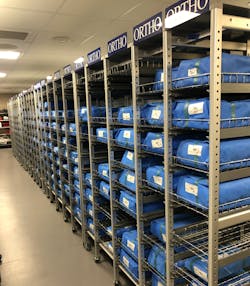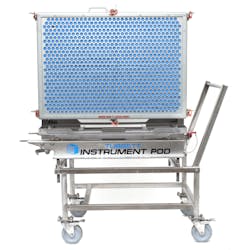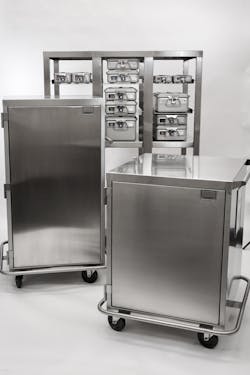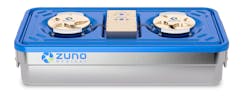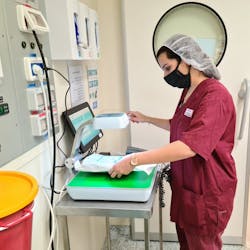The changing landscape of sterile processing storage and containment
Surgical procedures continue to evolve, as do the instruments required to perform them. In some cases, instrument sets have grown bigger with the addition of items, requiring trays with greater capacity or multiple trays for a single procedure. Complex and delicate instrument sets present their own challenges with organization and maintaining integrity. Then there are the vast number of disposable supplies required to perform surgical cases.
Faced with these challenges, sterile processing (SP) teams are reconfiguring spaces and processes and implementing new products and solutions. Healthcare Purchasing News (HPN) asked SP professionals for their success stories in containment and storage, and suppliers of these solutions for their comments and latest innovations.
Sterile processing successes in containment and storage
During my recent HPN Fireside Chat, “Sterile Processing Insights for Today’s Demanding Landscape,” I stressed the need for increased best practice sharing among SP professionals and teams.
For this article, Sean Weir, Sterile Processing System Educator, UPMC, Pittsburgh, shared his story of managing both a wrapped tray to rigid pan conversion, and installation of new SP department storage racks at two hospitals. Dena Ramirez, MSOL, CHL, CRCST, CIS, Sterile Processing Manager for Moffitt Cancer Center in Tampa, and CEO of The Ramirez Institute of Sterile Processing, shared her story of transitioning from stacked wrapped trays to each tray having its own shelf in storage.
Container and rack conversion at UPMC
With regards to the rigid tray conversion, Weir explained how wrapped trays tend to get “banged around” in the operating room (OR), leading to tears and holes. He offered this example:
“I checked a wrapped tray to ensure there were no breaches, sent it up to the OR in our dedicated clean elevator, and received a call from the OR team that there was a hole in it. I inspected the tray and there was a big slice in the wrap that wasn’t there when I sent it up.”
Weir embarked on a rigid tray conversion for all trays that could be containerized—80% of the hospital’s inventory. He explained why he chose to standardize on a single container manufacturer:
“It removed the questionability of having 2-3 different filters, which locks to buy, all the consumables, etc.”
The chosen containers were lighter in weight compared to competitor’s trays, which was an important selling point, said Weir:
“Some manufacturers’ rigid pans weigh about a half pound or 1 lb. more than others. You may not think that makes a difference, but when you are weighing out your trays and they must be under 25 lbs. inside the rigid pan, that extra pound could make a difference.”
Another hospital was remodeling its SP department, so Weir took the opportunity to maximize its storage space (and that of another hospital). They selected DSI racks, which Weir said are space-saving, easy to assemble and use, and easy to clean because of their design.
Weir’s advice to other SP teams when selecting vendors for containers and racks is “Customer service is the most important factor. These are capital expenses; therefore, the vendors should be there onsite to support your team. When one hospital converts, all the other hospitals in the system will look at how well the installation went and the quality of customer service provided.”
Weir continued, “With the rigid pans, the vendor’s regional manager and local reps unloaded the products, broke them down and helped us get them into circulation. If the vendor didn’t provide this level of support, I would never buy from that company again. The rack conversion was just as smooth. DSI worked alongside our team, and we got the installation done in only three days.”
DSI vice president, Ian Loper, said, “The storage equipment inside the four walls of an SPD is equally as important as the sterile instrumentation being stored in the department. This comparison equates to high importance. Without the right equipment, the people in the department can’t function as safely and efficiently as they should be, reducing employee morale and increasing costs. Workflow bottlenecks, disorganized storage, compliance risks, employee safety, infection control, and wasted space are all directly related to the design and functionality of the storage equipment being used within the room. The storage area often takes up the most space within an SPD so why not do everything possible to optimize and upgrade the space?”
Shelving to eliminate stack at Moffitt Cancer Center
Ramirez made the switch from stacking wrapped trays to individually shelving wrapped trays at previous facilities and saw the benefits in terms of protecting trays from wrap breaches. When she joined Moffitt Cancer Center as Sterile Processing Manager, she wanted to take the same approach, leveraging Metro’s MetroMax qwikTRAK floor track shelving to maximize storage capacity while maintaining wrapped tray integrity by storing trays individually.
Ramirez’s advice to other sterile processing managers when making the switch in tray storage is “Involve your team. I am a hands-on manager. Involving the technicians and getting their input was critical. We measured every shelf and made it exact to the size of the tray so we wouldn’t lose any space.”
Dave Salus, market manager, Healthcare Division, Metro added, “It’s important to consider three aspects of instrument pack storage. For wrapped packs, the material of construction or surface must be smooth and free of sharp edges that can snag or tear the wrap material.”
Salus continued, “Storage flexibility is key to achieving the most efficient use of the storage space available. Longer shelves with adjustable dividers provide the flexibility to size the storage compartment to the pack size, whereas narrow shelves with fixed uprights every 15 inches leave much unused space surrounding smaller packs or offer no option for oversized containers. Storage solutions utilizing antimicrobial properties will help keep the storage compartments cleaner between cleanings.”
Continuous change drives broadening solutions
Change is continuous in both the OR and SP department, whether it is additional instrumentation for a new surgeon or specialty, or a shift where procedures and reprocessing are performed. Here are some ways container and cart suppliers are helping these teams adapt to change.
Addressing space constraints in ASCs
During her career, Barbara Ann Harmer, MHA, BSN, RN, vice president of Clinical Services, Innovative Sterilization Technologies (IST), has been involved in the construction of 45 ambulatory surgical centers (ASC) across the U.S. She commented on how most ASCs were designed with very limited instrument and supply storage capacity that can’t accommodate today’s volumes.
“In the ASC world, we have an absolute need for storage because so many procedures have shifted to this setting in the past 30 years (e.g., implant procedures, retina procedures) and the numbers of sets and disposables required are greater than they were previous to this,” Harmer commented. “There are a number of companies providing offsite sterile processing services for ASCs today, as well as healthcare organizations building their own offsite locations to reprocess instruments for their own ASCs.
She explained how IST has broadened its product family to include OneCart, a sealed case cart featuring a “modular, sleek and modernistic” design that is vertical rather than horizontal.
She noted that with ASCs and other facilities sending their trays offsite for reprocessing, OneCart is “perfect” for organizations that must transport carts. “It is easier to secure in a truck because it doesn’t require much space. From a sterile barrier perspective, OneCart features a sealing feature when you close it. It has a built-in tag that can be switched from dirty to clean, and is able to be locked when instrument integrity is a concern.”
OneCart is designed to house IST OneTrays and be used in conjunction with the company’s EZ-Trax modular set up for instrumentation.
Consolidating trays in one contained place
As Kelly Truppo, territory sales manager, Product & Marketing Specialist, Turbett Surgical, pointed out, it is not just storage space constraints that burden sterile processing teams, but also finding trays in storage when they are needed.
"When it comes to storage, locating instrument trays you need for a procedure is always a consideration for sterile processing departments,” said Truppo. “The Turbett Surgical Instrument Pod ensures all the instrument trays you need for a single procedure are in one place. Multi-tray rigid containers also eliminate the need for racks to store stacks of blue wrapped or single rigid container trays, creating more space in sterile processing departments."
Containers and carts in a range of sizes
Healthcare facilities come in various sizes, with different surgical specialties performing varying levels of procedural volumes. Therefore, manufacturers of containers and case carts that offer a wide variety of options are well positioned to meet their range of needs, according to Marcia Frieze, CEO, Case Medical.
“At Case Medical, we design based upon usage,” said Frieze. “Like a ‘Russian Matryoshka Doll’ each of our containment systems fits seamlessly one into another. Our SteriTite container aligns with the devices within. Our case carts fit the full range of containers. Having a range of sizes enables us to meet the needs of large medical centers, as well as small community hospitals and ambulatory surgery centers. In addition, we have a small case cart that can fit under a counter that we designed for the VA Health System that is fully transportable, closed and sits under a counter in their clinics. We also have small containers that have U.S. Food and Drug Administration (FDA) clearance for tabletop autoclaves, ideal for clinics and physician's offices.”
“A sealed container provides the utmost in containment during storage and transport of sterilized medical devices,” said Frieze. “Where open case carts used to be commonly used, closed case carts have replaced them as a more secure option. At Case Medical, we manufacture both sterilization containers and case carts that meet current standards for storage, transport, and handling. We use only reusable materials that are anodized and passivated for corrosion resistance.”
Frieze added, “Further, both our containers and case carts have a unique barcode for tracking and tracing, working seamlessly with our CaseTrak360 software. No need for sticky labels, tarps to cover the open carts or wrap for sterile packaging."
Safely securing devices during transport
With more healthcare facilities transporting instruments and trays between various locations, keeping these assets organized and protected from damage has grown in importance. Manufacturer of engineered materials and custom packaging solutions Spartech has developed its MediSheet solution to securely retain medical devices on mounting cards placed within sterile packaging during shipment, storage, and ultimately surgery.
Spartech strategic accounts manager, Kendall Faulstich, noted, “Other medical product applications for MediSheet include everything from medical trays to safely securing tubes used during colonoscopy procedures. It’s available in sheet and custom die-cut cards.”
Considering efforts to reduce healthcare’s environmental footprint, Spartech manufactures MediSheet using a polyethylene material. “It is a more environmentally friendly alternative compared to PVC when medical waste is incinerated for disposal,” said Faulstich. “In addition, this option can replace lidded trays to reduce the amount of material used in the packaging.”
Instrument containment goes high tech
Digital solutions are transforming healthcare in many ways. So why not sterile processing? Here is the story of how Zuno Medical developed its rigid sterilization containers with electronic monitoring.
The surgical team is preparing for a procedure. They open a standard rigid container and there is no filter, or they find a hole in a wrapped instrument set. The case is delayed until another instrument set can be found and reprocessed, and in the worst case, the procedure is cancelled.
“As orthopedic representatives in the operating room (OR), the founders of Zuno Medical experienced countless instrument processing errors,” said Allan McNichol, CEO of Zuno Medical. “With current subjective methods to evaluate sterile barriers such as OR staff holding blue wrap to the light, they thought to themselves ‘there has to be a better way.’”
The result is the Zuno Smart Container, “the first-ever sterilization container designed to increase efficiency across both SPD and OR by improving turnover times,” according to McNichol. During the autoclave sterilization cycle, the Zuno Smart Container creates a vacuum seal, eliminating a porous barrier and the need for container disposables—saving prep time in SPD and evaluation time in the OR. The container continues to maintain and monitor the seal during transport and storage, enabling objective verification that the container's sterile barrier has not been compromised.
A two-step verification system consisting of both a visual and a tactile check allows users to confirm the sterile barrier is intact at any time and most critically before a set arrives in the OR.
“It’s been a long journey. Running smart devices inside a high-pressure steam autoclave is not necessarily an easy task,” McNichol continued. “We’re extremely proud to have received FDA De Novo clearance in a brand-new category—rigid sterilization containers with electronic monitoring.”
The Zuno Medical team worked extensively with SP and OR teams in hospitals and surgery centers across the country to develop the Zuno Smart Container and ensure it met their needs. There were some valuable lessons learned along the way, including key design features such as a green checkmark instead of just a green light for users who may be color blind and space-saving concepts taking limited storage capabilities into account.
Having secured FDA clearance, Zuno Medical is planning commercialization of the Zuno Smart Container for Q4 of 2023.
Sidebar:
Leveraging AI to track device and supply usage
“Not all medical devices that go into the human body during a procedure are captured correctly,” said Craig Crock, principal, Southwest Solutions Group. “This creates an environment where the billing to the client is not accurate. This process currently is very manual. The other issue is if there is a future recall on that device by serial number, they may not have correctly documented the device and will not know which patients are at risk.”
Crock explained how the automated process requires minimal effort from hospital staff. “To start, the implant tracking system takes a snapshot of all the items used in the procedure. All the nurses have to do is place each item on the pad; the device snaps a picture, and when the light on the pad turns green, the nurse removes the item and repeats the process as needed.”
Once a picture is taken, the image converts into machine-readable data. Using cloud-based AI management software, the system identifies the batch number, serial number, expiration date, and manufacturer SKU, and records this information directly into the patient’s electronic file.
“If an item is unrecognized, the Identi inventory management software back-office support team will complete the information and update the item master, with no work required by hospital staff,” Crock added. “The hospital charge-capture information automatically uploads into the hospital and vendor ERP/EHR systems for accurate billing, easy stock replenishment, and improved operating room supply management.”
About the Author
Kara Nadeau
Senior Contributing Editor
Kara Nadeau is Sterile Processing Editor for Healthcare Purchasing News.

